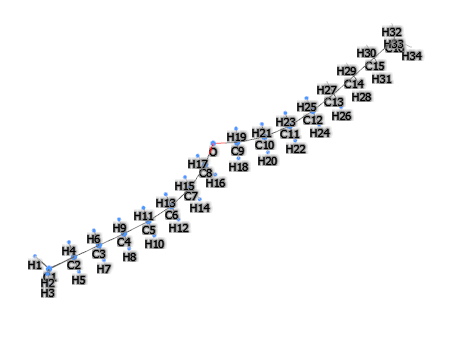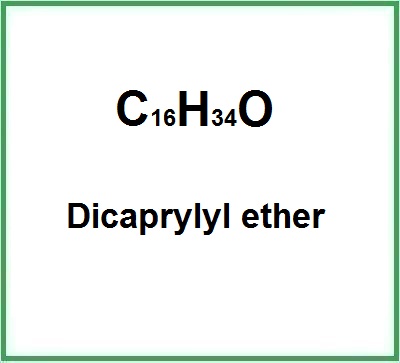![]() Dicaprylyl ether
Dicaprylyl ether
Rating : 7
| Evaluation | N. Experts | Evaluation | N. Experts |
|---|---|---|---|
| 1 | 6 | ||
| 2 | 7 | ||
| 3 | 8 | ||
| 4 | 9 | ||
| 5 | 10 |
10 pts from FRanier
| Sign up to vote this object, vote his reviews and to contribute to Tiiips.Evaluate | Where is this found? |
| "Dicaprylyl ether studies" about Dicaprylyl ether Review Consensus 10 by FRanier (9971 pt) | 2022-Nov-14 16:29 |
| Read the full Tiiip | (Send your comment) |
Compendium of the most significant studies with reference to properties, intake, effects.
Kirilov, P., Franceschi-Messant, S., Lukyanova, L., Perez, E., & Rico-Lattes, I. Colloidal nanoparticles of gelled oil–elaboration process and characterization.
Abstract. The aim of this study was to elaborate a stable dispersion of organogel nanoparticles in water. Organogels are soft materials, which result from the immobilization of an organic liquid in a three-dimensional network by a gelator. The organogels in this study were obtained from an organic oil and a low molecular-mass organic gelator (LMOG). These organic gelators have several advantages over polymer gelators because of their greater flexibility of use and their gelling capacity even in very small quantities. LMOG based organogels are usually prepared by dissolving the gelator in an oil at high temperature and then cooling the solution below its characteristic sol-gel transition temperature (Tgel). Tgel is empirically defined as the temperature below which flow is not discernible. It depends on the concentration of the gelator, the properties of the oil (polarity, viscosity, etc.) and, in some cases, the conditions of cooling. ...
Guglielmini, G. (2008). Nanostructured novel carrier for topical application. Clinics in dermatology, 26(4), 341-346.
Abstract. Nanoemulsions have attracted considerable attention in recent years for application in personal care products as potential vehicles for the controlled delivery of cosmetics and the optimized dispersion of active ingredients in particular skin layers. Of the many techniques that have been developed to measure droplet size of emulsions, 2 are of interest: laser light scattering and energy-filtering transmission electron microscopy used to measure the size of droplets in a nanoemulsion formed by a novel emulsifying agent that is able to spontaneously create emulsions with droplet sizes smaller than 300 nm.
Hill, K. (2007). Industrial development and application of biobased oleochemicals. Pure and Applied Chemistry, 79(11), 1999-2011.
Abstract: In concepts for new products, performance, product safety, and product economycriteria are equally important. They are taken into account already when the raw materialsbase for a new industrial product development is defined. Here, renewable resources gain—again after the earlier “green trend” in the 1980s—increasing attention as an alternative rawmaterials source compared to fossil feedstock. The industrial use of carbohydrates, proteins,and vegetable oils aligns perfectly with the principles of Responsible Care and is an impor-tant part of green chemistry and sustainability in general.Since the 1950s, oleochemistry has grown to a major research and technology area inseveral institutions and industries. A large variety of products based on fats and oils havebeen developed since then for different uses, such as specialties for polymer applications,biodegradable mineral oil replacements for lubricants, and surfactants and emulsifiers for thehome and personal-care industries. However, at present it seems that the use of renewable re-sources, especially vegetable oils, has to compete more and more with the increasing demandfor bioenergy, which could cause an unbalanced supply and demand in the future or even athreat for the increasing demand for food in certain areas of the world.
Ghalleb, S., De Vaugelade, S., Sella, O., Lavarde, M., Mielcarek, C., Pense‐Lheritier, A. M., & Pirnay, S. (2015). Predictive microbiology for cosmetics based on physicals, chemicals and concentration parameters. International Journal of Cosmetic Science, 37(1), 70-75.
Abstract. Challenge test (CT) is essential to assure the efficiency of the preservative system in products. A previous study realized by our staff in 2012, carried out to evaluate the influence of three parameters (ethanol, pH and water) on the microbiological cosmetics products conservation. Following this work, a correlation between aw (based on the glycerine concentration) and the selected parameter has been demonstrated. In the present study, smaller limits of ethanol, pH and glycerine were applied to determinate CT necessity....Following the analysis of the different concentration, a correlation between glycerine and ethanol that directly influence microbiological protection of cosmetics products has been established. Indeed, by controlling ethanol, pH and glycerine, many products may be exempted from the CT.
Engels, T., Förster, T., & Von Rybinski, W. (1995). The influence of coemulsifier type on the stability of oil-in-water emulsions. Colloids and Surfaces A: Physicochemical and Engineering Aspects, 99(2-3), 141-149.
Abstract. Oil-in-water emulsions containing ethoxylated non-ionic surfactants may undergo a phase inversion to water-in-oil emulsions on heating. This temperature-induced phase inversion is utilized in the so-called phase inversion temperature (PIT) method for the preparation of finely dispersed bluish oil-in-water emulsions. PIT emulsions with polar oil components were prepared by adding mixtures of fatty alcohol ethoxylates with or without the coemulsifier glyceryl monostearate. In the phase inversion temperature range, microemulsion or liquid crystalline phases are formed depending on the type of emulsifier mixture used. The formation of a bicontinuous or lamellar structure is essential in order to obtain finely dispersed oil-in-water emulsions. In both phases the hydrophilic-lipophilic properties are balanced, which results in minimum interfacial tensions between oil and water phases. Fine dispersity, however, is not the only criterion for stable oil-in-water emulsions. Studies of different parameters of the emulsions give hints to the stabilization mechanism of the emulsifier/coemulsifier system. According to these results, low viscous PIT emulsions exhibit long-term storage stability, if the oil droplets are shielded against coalescence by a lamellar gel phase, which is imparted by the coemulsifier glyceryl monostearate.
| Sign up to vote this object, vote his reviews and to contribute to Tiiips.EvaluateClose | (0 comments) |
| "Descrizione" about Dicaprylyl ether Review Consensus 10 by FRanier (9971 pt) | 2023-Nov-20 10:41 |
| Read the full Tiiip | (Send your comment) |
Dicaprylyl ether is a chemical compound extracted by a rather complex process involving a catalytic dehydration of octanol-1 in the presence of Cu at a temperature of 195-200°C for 8-12 hours. It can be obtained from palm oil and coconut oil.
The name describes the structure of the molecule:
- Dicaprylyl refers to the presence of two caprylic groups in the molecule. The caprylic group is derived from caprylic acid, a type of medium-chain fatty acid, and has the structure C8H17-.
- ether refers to a class of organic compounds that contain an ether group, an oxygen atom attached to two alkyl or aryl groups.
It appears as a colourless transparent liquid, stable, flammable and incompatible with strong oxidising agents.

Cosmetics
Skin conditioning agent. It is the mainstay of topical skin treatment as it has the function of restoring, increasing or improving skin tolerance to external factors, including melanocyte tolerance. The most important function of the conditioning agent is to prevent skin dehydration, but the subject is rather complex and involves emollients and humectants that can be added in the formulation.
Skin conditioning agent - Emollient. Emollients have the characteristic of enhancing the skin barrier through a source of exogenous lipids that adhere to the skin, improving barrier properties by filling gaps in intercorneocyte clusters to improve hydration while protecting against inflammation. In practice, they have the ability to create a barrier that prevents transepidermal water loss. Emollients are described as degreasing or refreshing additives that improve the lipid content of the upper layers of the skin by preventing degreasing and drying of the skin. The problem with emollients is that many have a strong lipophilic character and are identified as occlusive ingredients; they are oily and fatty materials that remain on the skin surface and reduce transepidermal water loss. In cosmetics, emollients and moisturisers are often considered synonymous with humectants and occlusives.
Solvent. It is the substance for dissolving or dispersing surfactants, oils, dyes, flavourings, bactericidal preservatives in solution.In fact, it dissolves other components present in a cosmetic formulation. Solvents are generally liquid (aqueous and non-aqueous).
It is also added as a generic excipient.
Medical
In the pharmaceutical industry it is used in dermatological formulations as an emollient (1).
Other uses
It has rheological properties to improve fluid flow (2).
For more details:
Typical commercial product characteristics Dicaprylyl ether
| Appearance | Colorless liquid |
| Boiling Point | 286-287°C |
| Melting Point | −7.6° |
| Flash Point | >110°C |
| Density | 0.806 g/mL at 25°C |
| Refraction Index | n20/D 1.433 |
| PSA | 9.23000 |
| LogP | 5.72400 |
| Loss on drying | ≤0.5% |
| SO4 | ≤0.1% |
| Cl | ≤0.01% |
 |  |
 |  |
- Molecular Formula C16H34O
- Molecular Weight 242.44
- Exact Mass
- CAS 629-82-3
- UNII 77JZM5516Z
- EC Number 211-112-6
- DSSTox Substance ID DTXSID20862324
- IUPAC 1-octoxyoctane
- InChl=1S/C16H34O/c1-3-5-7-9-11-13-15-17-16-14-12-10-8-6-4-2/h3-16H2,1-2H3
- InChl Key NKJOXAZJBOMXID-UHFFFAOYSA-N
- SMILES CCCCCCCCOCCCCCCCC
- MDL number MFCD00009563
- PubChem Substance ID 24855006
- ChEBI 88651
- RXCUI 1367138
- RTECS RH8800000
- NSC 28948
Synonyms :
- Caprylic ether
- 1,1’-oxybisoctane
- Dioctyl ether
- 1-octoxyoctane
References___________________________________________
(1) Marcato B, Guerra S, Vianello M, Scalia S. Migration of antioxidant additives from various polyolefinic plastics into oleaginous vehicles. Int J Pharm. 2003 May 12;257(1-2):217-25. doi: 10.1016/s0378-5173(03)00143-1.
Abstract. The migration of the antioxidant additives pentaerythrityl tetrakis(3,5-di-tert-butyl-4-hydroxyphenyl)propionate (Irganox 1010) and tris(2,4-di-tert-butylphenyl)phosphite (Irgafos 168) from polyolefinic packaging into oily vehicles was investigated. The polyolefins included in the study were from the following classes: isotactic polypropylene homopolymer (PP), ethylene-co-propylene random copolymer (RACO), ethylene-propylene heterophasic copolymer and ethylene-propylene amorphous copolymer blend (EP) and high-density polyethylene (HDPE). Each polymer was additioned with Irganox 1010 (0.15%, w/w) and Irgafos 168 (0.15%, w/w) and processed into blown bottles. To study the antioxidant release process, plastic sheets were cut from the bottles and dipped for various time intervals into a mixture of five oils (caprylic/capric triglyceride, cyclomethicone, dicaprylyl ether, isohexadecane and C(12-15) alkyl benzoate) representative of lipophilic excipients used in pharmaceutical and cosmetic formulations. After exposure to the oil medium, the non-migrated Irganox 1010 and Irgafos 168 were recovered from the polymeric matrices using microwave-assisted extraction with ethyl acetate-hexane and assayed by HPLC. The leaching of the two antioxidants varied remarkably depending on the polyolefin crystallinity and structure. The amount of Irganox 1010 transferred into the contact medium at 25 degrees C decreased in the order EP>RACO>PP>HDPE. The same polyolefin ranking was observed in the case of Irgafos 168, except for PP and HDPE which exhibited similar depletion of this additive. Migration of Irgafos 168 was greater than that of Irganox 1010 and the release of both antioxidants increased at higher temperature (50 degrees C). The obtained data are useful for the selection of polyolefinic matrices as raw-materials for the production of pharmaceutical and cosmetic containers.
(2) Kirilov P, Gauffre F, Franceschi-Messant S, Perez E, Rico-Lattes I. Rheological characterization of a new type of colloidal dispersion based on nanoparticles of gelled oil. J Phys Chem B. 2009 Aug 13;113(32):11101-8. doi: 10.1021/jp905260s.
Abstract. The rheological properties of a new type of colloidal dispersion based on nanoparticles of gelled oil have been characterized. The nanoparticles (mean diameter approximately 250 nm) were viscoelastic droplets of dicaprylyl ether gelled by 12-hydroxystearic acid (HSA) and were stabilized in aqueous solutions by cetyltrimethylammonium bromide. The effects of the volume fraction of the dispersed organogel phase and of the organogelator concentration upon viscoelasticity of the dispersion were investigated and compared to the corresponding emulsion (without HSA). The shear viscosity of the dispersions of organogel droplets and the elastic and viscous moduli (G' and G'') were found to increase when the proportion of organogelator was increased. More surprisingly, the shear-thinning behavior was also more pronounced. The rheological behavior of the dispersions could be explained by strong interactions between some gelled particles. This hypothesis was supported by electron microscopy observations showing some particles bridged together by ribbons of HSA fibers.
| Sign up to vote this object, vote his reviews and to contribute to Tiiips.EvaluateClose | (0 comments) |
Read other Tiiips about this object in __Italiano (2)
Component type: Chemical Main substances: Last update: 2023-06-21 18:57:53 | Chemical Risk: |


